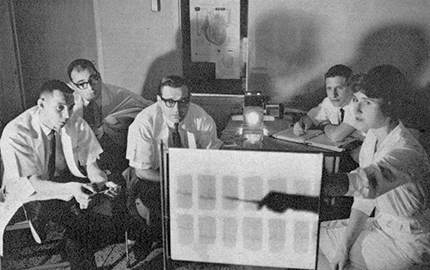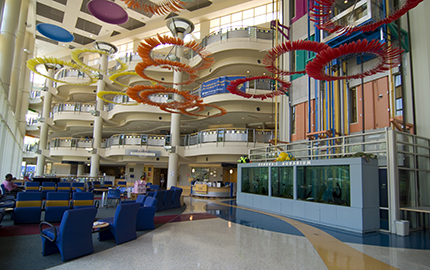Though it is the youngest of the nation's leading medical enterprises, the component entities of Duke Health have grown into one of the country's largest clinical and biomedical research institutions. Duke Health encompasses a health system that spans 32 counties in North Carolina and includes areas in neighboring states. Here are some highlights from the history of Duke Health.
- 1924Duke University created
Industrialist and philanthropist James B. Duke establishes The Duke Endowment, part of which transforms Durham's Trinity College into Duke University.
- 1925Schools of Medicine, Nursing and Duke University Hospital established
James B. Duke makes an additional bequest to establish the Duke University Schools of Medicine and Nursing and University Hospital. The goal: improving health care in the Carolinas and nationwide.
- 1930Duke University Hospital opens
Duke University Hospital opens to patients on July 21. The event attracts 25,000 visitors.
- 1930Classes begin for Schools of Medicine and Nursing
On Aug. 15, 1930, classes at the Medical School begin, while the first classes for nursing students begin on Jan. 2, 1931.
- 1931Private Diagnostic Clinic organized
The clinic provides coordinated medical and surgical care to private patients with moderate incomes.
- 1935Ranked among nation's best
The Association of American Medical Colleges ranks Duke among the top 25 percent of medical schools in the country - less than five years after it opened.
- 1936Ultraviolet lamps in operating rooms
Duke surgeon J. Deryl Hart uses ultraviolet lamps in operating rooms to kill airborne germs that cause post-operative staph infections. The number of infections and related deaths declines dramatically.
- 1937First brain tumor program
Duke establishes the nation's first brain tumor program, launching what will become a leader in the field.
- 1950Medication safety
Duke pediatric expert leads the push for drug companies to develop child-proof safety caps for medicine bottles.
- 1950Lenox Baker Children's Hospital dedicated
The 40-bed North Carolina Cerebral Palsy Hospital is dedicated. It is later renamed Lenox Baker Children's Hospital.
- 1955First center for aging
The Duke University Center for Aging, the first research center of its kind in the nation, is established.
- 1956Systemic hypothermia during surgery
Duke surgeons become first to use systemic hypothermia during cardiac surgery. The technique of cooling patients' body temperatures minimizes tissue damage during lengthy surgeries. The practice is now standard worldwide.
- 1958First clinical nursing specialist program
The Medical-Surgical Nursing Department develops the clinical nursing specialist program, the first master's program of its kind in the United States.
- 1963First African American student
Duke University School of Medicine admits its first African American student, Wilhem Delano Meriwether.
- 1965Nation's first PA program
Duke establishes the nation's first Physician Assistant Program.

- 1968Protecting against oxygen toxicity
Duke scientists discover the enzyme that protects living things against the toxicity of oxygen.
- 1969Deep-sea dive research
In its hyperbaric chamber, Duke conducts the first recorded studies of humans' ability to function and work at pressures equal to a 1,000-foot deep-sea dive.
- 1969Databank for Cardiovascular Disease created
The Duke Databank for Cardiovascular Disease is created. It is today the world's largest and oldest databank on heart care outcomes.
- 1971Comprehensive cancer center
The Duke Comprehensive Cancer Center becomes one of the nation’s first cancer centers established by the National Cancer Act. It is designated a "comprehensive" cancer center by the National Cancer Institute in 1973.
- 1973Duke Eye Center opens
The Eye Center opens and is dedicated on November 8.
- 1980New Duke University Hospital
The new $94.5-million, 616-bed Duke University Hospital opens north of the original hospital. The total number of patient beds tops 1,000.
- 1985First AZT trial
Duke becomes one of two hospitals to conduct the first human clinical trials of AZT, the first drug developed to treat HIV/AIDS.
- 1990Newborn screening
Duke geneticists invent a three-minute test to screen newborns for over 30 metabolic diseases at once. The test is now routinely used throughout the country.
- 1992First outpatient bone-marrow transplant program
Duke Comprehensive Cancer Center develops the nation's first outpatient bone-marrow transplantation program.
- 1992Transplant milestones
Duke performs its first lung transplant and its first heart/lung transplant.
- 1993First successful thymus transplant
Duke pediatric immunologist Louise Markert, MD, develops the first treatment of its kind for babies with DiGeorge Syndrome suffering from thymus abnormalities.
- 1993Alzheimer's gene
Duke researchers identify apolipoprotein E (apoE) as the major susceptibility gene for Alzheimer's disease. It is one of many genetic risk factors for disease identified at Duke.
- 1993Largest clinical trial
Duke enrolls the final patient in GUSTO-I, the largest clinical trial conducted in the United States. The trial infrastructure formed the foundation for the Duke Clinical Research Institute (DCRI), the nation's foremost academic clinical trials center.
- 1995BRCA1 and BRCA2 genes
Duke scientists help discover the BRCA1 and BRCA2 genes responsible for many inherited forms of breast and ovarian cancers.
- 1996Duke Clinical Research Institute established
The Duke Clinical Research Institute is established. DCRI conducts large, multinational clinical trials, manages major national patient registries, and performs outcomes research.
- 1998Duke University Health System established
Duke University Health System is created as Duke establishes partnerships with Durham Regional Hospital (now Duke Regional Hospital), Raleigh Community Hospital (now Duke Raleigh Hospital), and other regional health care providers and practices.
- 2000Children’s Health Center opens
The McGovern-Davison Children’s Health Center opens, bringing all of Duke’s pediatric specialties under one roof. The $32.5 million facility is completely paid for through philanthropy.

- 2003Duke-NUS Medical School established
Duke Health and the National University of Singapore partner to establish that country's first graduate medical school. The new school is based on Duke's medical school curriculum and the U.S. model in which students enter medical school after earning their baccalaureate degree.
- 2004Raleigh Community becomes Duke Raleigh
Raleigh Community Hospital changes its name to Duke Raleigh Hospital, introducing Wake County residents to newly expanded services including a cardiovascular center and cancer center.
- 2005Center for HIV/AIDS Vaccine Immunology (CHAVI)
Duke is selected by the National Institutes of Health to lead the $300 million Center for HIV/AIDS Vaccine Immunology (CHAVI). The consortium of research universities is dedicated to HIV vaccine research, development and design.
- 2006First treatment for Pompe disease
The FDA approves a lifesaving treatment developed at Duke for Pompe disease, a previously fatal genetic disorder.
- 2006Global Health Institute established
The university-wide Global Health Institute is launched to promote education, research and service in health care to underserved populations globally.
- 2006Nursing establishes doctoral degree program
The Duke University School of Nursing admits the first students into its new doctoral degree program. The school also opens a new facility that unites all nursing education and research programs on one campus.
- 2006Hospitals' Magnet designation
Duke University Hospital is named a Magnet Hospital by the American Nurses Association. Less than 4 percent of U.S. hospitals hold the distinction. Durham Regional achieves Magnet status in 2008; Duke Raleigh follows in 2009.
- 2007First map of imprinted genes
Duke scientists create the first map of imprinted genes throughout the human genome. The mapping reveals four times as many imprinted genes as had previously been identified.
- 2011First graduating class of Duke-NUS
The first class of the Duke-NUS Doctor of Medicine program graduates.
- 2012Duke Cancer Center opens
A new Duke Cancer Center facility opens, a state-of-the-art patient care center that consolidates in one location almost all outpatient clinical cancer care services.

- 2012Nobel Prize winner
Robert Lefkowitz, MD, professor of medicine, wins the Nobel Prize in Chemistry.
- 2013Electronic health record
Duke University Health System becomes the first provider in the greater Triangle region to implement the country's leading electronic health record (EHR) system. Duke University Hospital and 223 outpatient facilities use the state-of-the-art system.
- 2013Duke Medicine Pavilion opens
Duke Medicine Pavilion, a major expansion of Duke University Hospital, opens. The eight-floor, 608,000 square-foot building includes 160 critical care rooms, 18 operating rooms and an imaging suite.
- 2013First bioengineered blood vessel
In a first-of-its-kind operation in the United States, a team of Duke surgeons transplants a bioengineered blood vessel into a patient's arm. Duke surgeons helped create the vessel.

- 2013Medical research honor
Blake Wilson, co-director of the Duke Hearing Center wins the 2013 Lasker-DeBakey Clinical Medical Research Award for his role in the development of cochlear implants.
- 2013Durham Regional becomes Duke Regional Hospital
On July 1, 2013, Durham Regional Hospital becomes Duke Regional Hospital.
- 2013New home for Medical School
The Mary Duke Biddle Trent Semans Center for Health Education opens as the new home for the School of Medicine.
- 2014First bionic eye recipient
Duke doctors implant the seventh so-called "bionic eye" in the U.S., allowing a patient to see for the first time in 33 years.
- 2015New Eye Center opens
Duke opens the state-of-the-art Hudson Building at Duke Eye Center. The four-floor facility has 116,000 square feet.
- 2015Nobel Prize Winner
Paul Modrich, James B. Duke professor in the Department of Biochemistry, wins the Nobel Prize in Chemistry. The award recognizes his four decades of work on how mistakes in the DNA code are repaired.
- 2016Pioneering brain cancer therapy
The FDA awards Duke "breakthrough therapy designation" for their poliovirus therapy for glioblastoma. The therapy was developed and is being tested by researchers at Duke's Preston Robert Tisch Brain Tumor Center.
- 2016Califf named FDA deputy commissioner
Robert Califf, MD, vice chancellor of clinical and translational research at Duke University School of Medicine and a global leader in cardiovascular medicine, is named commissioner of the FDA.


